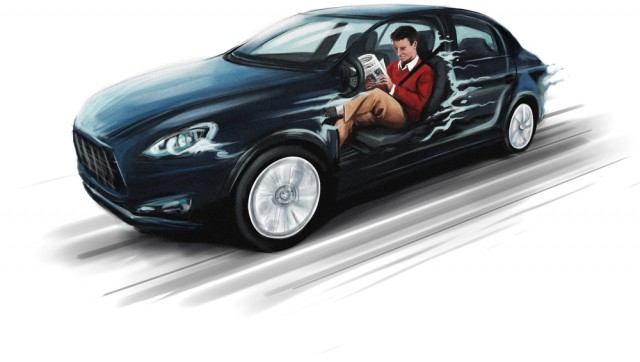The future of self-driving cars relies on big data

Autonomous cars depend on information. They’re equipped with technology to gather and communicate a vehicle’s position, speed, direction, and braking status. They also recognize traffic signals, proximity to pedestrians, and hazardous objects on the road. With voluminous data being computed in near real-time, self-driving cars can respond to dangers afoot or notify the car owner of imminent mechanical issues, in which case it might automatically set up an appointment with the nearest auto body shop.
In addition, self-driving vehicles aren’t disposed to human-prone errors resulting from distracted driving, tired driving, or driving while inebriated. They’re constantly alert, vigilant, and have a panoramic view of the road. All of this demonstrates how big data is becoming the cornerstone to the driverless car’s future. What’s more, it’s already making great strides toward self-driving capabilities, driver safety, and enhanced customer experience.
How Big Data is Already Driving the Auto Industry
Ford and Tesla have been harnessing big data to optimize customer experience and operational safety -- ultimately laying the groundwork for the fully autonomous vehicle. As part of this process, customers of both companies are essentially being used as test drivers.
Ford gathered data from over 4 million of their cars outfitted with sensors and remote application management software to improve fuel consumption and emissions, as well as quality standards. Even back in 2004, they installed their Aston Martin DB9 with a neural network to optimize engine performance and tailor its functions around unique driving habits.
In similar fashion, Tesla offered an optional technology package to customers in 2014, which employed cameras and sensors to support collision warning systems and learn about driving behaviors. Following a year of accruing and analyzing data from these channels, Tesla sent out an update giving 60,000 cars self-driving abilities, which enabled them to govern steering, braking, speed, and lane-changing. Much like a laptop or phone, the update was automatic; customers didn’t have to bring their car into a dealership or a shop.
These aren’t the only two players in the data-collection game, either. Other major automakers have begun to prioritize big data in some form or another, including GM, Mercedes-Benz, Delphi Automotive, Bosch, and Nissan. In fact, McKinsey & Co., an international management consultant firm, projects big data in cars to become a $750 billion industry by 2030.
The Driverless Car’s Data-Driven Ecosystem
When thinking about the self-driving car’s future, it’s important to have a holistic outlook. The car itself is another cog -- albeit an important one -- in a vast data-gathering ecosystem. As with companies like Tesla, Ford and Mercedes-Benz, the car as we know it will be embedded with a powerful learning system, rendering fully autonomous capabilities and simultaneously creating a predictive user experience.
Autonomous cars employ a suite of technology, including GPS receivers, short-range wireless network interfaces, cameras, and an array of sensors (lidar, radar, inertial measurement units, wheel encoders, ultra-sonic, actuators, and more), in an effort to uphold inter-vehicle communication. But not only do vehicles interact with each other, they also communicate with sensors embedded in highway infrastructure and, of course, satellites, to help navigate labyrinthine streets, highways, and terrain, down to the nearest inch -- not to mention a variety of climates, temperatures, and weather conditions.
By establishing anchorage across these channels, data mining processes can help support safer driving, crash avoidance, traffic mitigation, positional awareness, and thus fully autonomous capabilities. Leveraging real-time information from these channels, companies can also correct issues before they arise, and in the case of Tesla, provide software updates instead of massive recalls, to fix a problem. In-car sensors can warn of mechanical failure ahead of time, which allow companies to better plan for their parts inventory. And reduced inventory means reduced costs and a more efficient supply chain, which in turn means customer satisfaction.
As cars continue to sync up to this sweeping system, they’ll be increasingly attuned to the ever-changing conditions of their environment, and become a data-driven organization. This is demonstrated by Ford’s partnership with Google, and GM’s insourcing of 10,000 IT personnel back in 2012, to establish two in-house, cost-efficient data centers. From different ends of the spectrum, tech companies and automakers are converging to forge a more data-centric car industry.
Moreover, when autonomous vehicles start using large datasets at critical mass, big data as we know it will get bigger. And the bigger big data is, the greater the potential for autonomous technology. In effect, driverless technology and big data will, in all likelihood, potentiate each other.
Photo Credit: LifetimeStock/Shutterstock
Stephanie Braun is a Director of Auto Product Management at Esurance, where she is responsible for designing the company’s auto product lines and managing telematics programs. She has 11 years of experience in the industry, focused primarily on the product design, product launches, pricing, and innovation of auto and renters insurance products.
